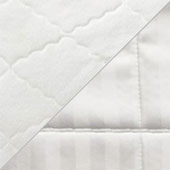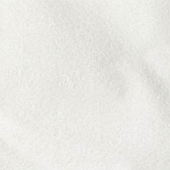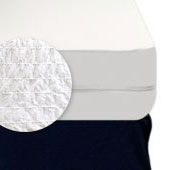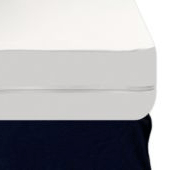Your Cart is Empty
General Waterproof Bedding Information
Advantages of Protective Bedding >>
How to Choose a Waterproof Mattress Pad >>
Why should I buy vinyl mattress protection? >>
Choices: Vinyl Mattress Pad or Vinyl Cover? >>
Comparing Different Bedding Solutions >>
Measuring for Mattress Protectors >>
Choosing a Waterproof Barrier >>
Allergies: Membrane vs. Non-Membrane Covers >>
What is the difference between the mattress pad and overlay? >>
Choosing between Fitted and Zippered Mattress Covers >>
How to Put on a Mattress Encasement >>
Why You Should Choose Organic Bedding >>
Crib Bedding Protection for Your Baby >>
The Most Economical Way to Protect Your Mattress >>
Washing Waterproof Bedding >>
How to Remove Mattress Stains and Odors >>
Protective Bedding Resources >>

Advantages of Protective Bedding
By using protective bedding, you can extend the life of the mattress. Whether you are saving it from bedwetting accidents or protecting your mattress from bedbugs and dust mites, protective bedding helps preserve your mattress in its original condition. Whether you are looking for plain plastic sheets or a plush, breathable mattress pad, we have a solution for you. Some of our most popular protective bedding products are:
- Vinyl covers: Also known as “plastic sheets,” these covers come in fitted or zippered styles and offer waterproof protection. They are easily wiped clean and usually last a couple of years with normal use. Zippered vinyl covers also offer allergy and bedbug protection.
- Waterproof Mattress Pads: These pads offer waterproof protection for the top of the mattress. They have skirted sides and many layers to provide protection and absorbency. Be sure to check the waterproof material for breathability to increase your comfort.
- Premium covers: These lightweight covers offer waterproof protection in a comfortable, breathable cover. The zippered mattress encasements are also bedbug and dust mite proof. The fitted covers wash easily and dry in one cycle.
- Underpads: Also known as “overlays,” these are great for nighttime wetting, or nocturnal enuresis! Most often seen in hospitals and nursing homes, underpads work great for young and old alike. Unlike a mattress pad, waterproof underpads lay on top of the fitted sheet and offer a quick change after soiling. Choose between reusable underpads or disposable underpads. Printed underpads are also available to match your decor or personality.
- Allergy Bedding: Allergy bedding protects against dust mites. Covers can be membrane or non-membrane - see below for more information. Allergy bedding is breathable, very comfortable, and offer invaluable protection to allergy sufferers. Be sure to cover the box spring for optimal protection (vinyl covers are an inexpensive box spring solution!).

How to Choose a Waterproof Mattress Pad
There are 3 main components in a waterproof mattress pad: waterproof barrier material, absorbent fill, and top material. We carry pads with two types of waterproof barriers: vinyl or urethane.
There are two main differences in these materials. First, urethane is breathable while vinyl is not. This is important because urethane allows body heat to be dispersed while vinyl reflects that heat back to you. While this may not be important for a child, many adults find vinyl covers can be hot and uncomfortable to sleep on. Secondly, vinyl wears more quickly and it is more likely to harden and crack (NOT washer/dryer safe) than urethane. Urethane is more expensive, but it will last longer.
For the fill, the more layers there are, the more plush the cover and the more absorbent the mattress pad is. If you are looking for a cover that is easy to wash and dries quickly, less may be more. Finally, the top material ranges from high thread count cotton sateen to a poly-cotton blend.

Why Should I Buy Vinyl Mattress Protection?
Protection: Vinyl mattress protectors are the most economical solution to protect your bed. Zippered vinyl covers protect your mattress from fluids, odors, allergens and bedbugs. This is an inexpensive way to add years of life to your mattress, while locking out moisture. The zippered covers surround the entire mattress or pillow and are specially treated to retard the growth of mildew and mold. They are easily cleaned with a damp cloth.
Bedbugs: Vinyl covers are the most economical way to protect your mattress from bedbugs, or control them once they have set in. Zippered covers can be placed over mattresses with bedbugs to encase the bugs until they die out. This process generally takes about a year. Don’t forget to also protect your pillows and box spring when treating bedbugs.
3-Gauge vs. 6-Gauge: Standard 3-gauge covers are a great value and meet most needs. For heavy-duty, institutional quality covers, choose the thicker 6-gauge vinyl. We always recommend 6-gauge covers for commercial properties or bedbug control as they resist tearing more than the 3-gauge.
Fitted or Zippered: Fitted vinyl covers are easy to change and put on the bed. Keep in mind that zippered covers only unzip on one end and must be gently pulled around the mattress on all sides. This means you will need to be able to lift your mattress. If you cannot lift your mattress or want something that is easy to put on and take off, a fitted cover may be for you. Keep in mind that fitted covers NEVER protect you from bedbugs or allergens. A fitted vinyl cover only protects your bed from moisture.

Choices: Vinyl Mattress Pad or Vinyl Cover?
In a mattress pad, the waterproof vinyl layer is sandwiched between layers of fabric. The vinyl sheet layer is not visible. Because the vinyl layer is protected, it is more durable and is machine washable. Vinyl mattress pads are also absorbent.
A vinyl cover consists of a single layer of vinyl which can either be fitted or zippered. Since vinyl does not allow air to pass through, it may not be as comfortable to sleep on compared to a breathable mattress cover. For people who are often hot when they sleep, vinyl may not be the best option. We recommend a urethane mattress pad or encasement for people who sweat a lot while sleeping.

Comparing Different Bedding Solutions
You can easily compare our different bedding solutions by viewing our Comparison Charts page. You can compare the types of waterproof bedding with the Waterproof Bedding Chart. Compare different types of allergy bedding with the Allergy Relief Bedding Chart.

Measuring for Mattress Protectors
When you are preparing to buy a mattress protector, measure your bed before ordering. The important measurements are: length, width, and depth. While length and width measurements are standard by bed size (twin, full, queen, king, etc) we still recommend you measure your bed to be sure you know what size you have.
Measuring the depth is most important because depth is not standardized. In the past, mattresses were 9 inches deep, but with pillow-top, memory foam, etc, there is now a wide range in depth. The depth is the height from the bottom of the mattress to the top. When in doubt, go up a size. You can tuck any excess fabric under, but trying to force a mattress that is too deep into a more narrow cover can cause the cover to tear.

Choosing a Waterproof Barrier
When selecting a waterproof mattress protector, one of the biggest decisions is whether to purchase a cover with a vinyl or urethane waterproof barrier. Learn about the differences between the two before purchasing:
Mattress pads with a vinyl barrier:
- Are not breathable
- Are more economical
- Take more drying time
- Can be hot to sleep on
Mattress pads with a urethane barrier:
- Allow heat transfer (stays cool during summer and warm during winter)
- Cost more
- Are quiet
- Wash & dry quickly
- Last longer

Allergies: Membrane versus Non-Membrane Covers
Allergy relief bedding come in two types: membrane and non-membrane. Membrane covers provide waterproof protection and have a non-fabric barrier. In addition to waterproof protection, the zippered version also provides bedbug protection.
Non-membrane covers are tightly woven fabric that feels like cotton and doesn't allow allergens to pass through. Although these covers are lightweight, silent, and comfortable, they do not give the added protection of being waterproof.

What is the Difference between the Mattress Pad and Overlay?
Mattress pads and mattress overlays (underpads) are quite different. Waterproof mattress pads are intended to be placed directly on the mattress under the sheets. The pad is the first layer of defense, protecting your mattress from harmful moisture or excrement. It is intended to be used only incidentally as it is cumbersome to remove, wash, and replace. When there is a bedwetting accident, the mattress pad and sheets have to be washed.
Overlay pads, also known as underpads, are great for frequent incontinence. Since they are the first line of defense in protecting beds from incontinence, they are often used in hospitals and nursing homes, and are great for potty training, too! The advantage of overlay pads is they are easy to change. Overlay pads are intended to be used over the fitted sheet. For small accidents, only the overlay pad has to be changed. Overlay pads do not protect the mattress because they do not cover the whole bed, and should only be used to help contain the mess, rather than protect the mattress or bed covers. Overlay pads are intended to be used in conjunction with a mattress protector of some kind. Washable underpads are available with or without tuck-in sides to help hold the overlay pad in place.
Underpads provide protection for the middle section of the bed, where moisture is most likely to occur. For frequent urination at night, we always recommend you use both a waterproof mattress pad or vinyl cover AND a mattress overlay.

Choosing between Fitted and Zippered Mattress Covers
When choosing between fitted and zippered mattress covers, there are two things to note: your level of dexterity and bedbug/allergy protection.
If you have difficulty picking up your mattress, then you might want to choose a fitted mattress cover. Fitted mattress covers are quicker and easier to put on and take off since they don’t encase the entire mattress.
If you have a bedbug problem or want to prevent one, you’ll need a zippered mattress cover. These covers also protect against allergens and dust mites because the zip closed to fully encase your mattress. Since fitted mattress covers only cover the top and sides of the mattress, they only protect against moisture and mildew.

How to Put on a Mattress Encasement
Since zippered mattress covers encase the entire mattress, they typically require two people to apply. Follow these easy directions, and your cover will go on in minutes:
- Lay the mattress and position it upright so that the head of the mattress is facing the ceiling.
- With one person on each side of the mattress, pull the opening over the head of the bed.
- Bunch the cover over the top of the mattress until the end of the cover meets the end of the mattress (similar to how you put on pantyhose).
- Gently slide the bunched material down the bed until smooth and the ends meet.
- Refrain from pulling and stretching the cover, as that can cause it to rip.
- Lay the mattress down and make sure that all corners are aligned before you zip up the mattress cover at the foot of the bed.
- Use a regular fitted sheet to cover your mattress encasement.
- Lastly, gently lift and place your mattress back on the bed frame. Don't slide the mattress as this can cause the cover to rip.

Why You Should Choose Organic Bedding
We spend one-third of our life in bed, so it makes sense to invest in high quality bedding. Although organic bedding may be more expensive than regular bedding, the long term benefits oftentimes outweigh the costs.
Organic bedding is made from all-natural fibers that have been grown without the use of harmful chemicals, synthetic fertilizers, or pesticides. Since they’re toxic-free, organic bedding provides a safer and healthier sleeping environment for babies and adults alike. Eco-friendly mattresses and natural bedding are also 100% hypoallergenic, which make them a great option for those with asthma, allergies, delicate skin, or eczema. You’ll also experience more comfortable sleep due to the high-quality materials used in organic bedding.
In addition to your own health benefits, organic bedding is great for the environment. Instead of using harmful chemical pesticides, organic farmers practice sustainable farming methods when growing cotton. Organic bedding is also biodegradable, which contributes to a green environment.
The Protective Bedding Store offers organic bedding that uses the Global Organic Textile Standard (GOTS), which indicates that the bedding is certified as 100% natural. You can also choose from waterproof organic bedding so you don’t have to sacrifice comfort for waterproof protection.

Crib Bedding Protection for Your Baby
At the Protective Bedding Store, we offer high quality waterproof pads for your baby’s sleeping situation, whether it be a crib, bassinet, or cradle. All mattress protectors are machine washable and almost all are organic, so that your child stays dry and comfortable. Choose from fitted bed mattress covers and waterproof protector pads.
The organic baby bedding from NaturePedic uses DrySleep technology, which makes the mattress pad breathable. This allows your child’s body heat to pass through while still providing waterproof protection. NaturePedic crib mattresses don’t contain latex, Phthalates, vinyl or PVC, so your baby will not be inhaling any harmful chemicals or fumes.

The Most Economical Way to Protect Your Mattress
To get the best bang for your buck, invest in vinyl mattress covers. These protective mattress covers are great for potty training, frequent urination, pet accidents, and adult bedwetting.
The fitted vinyl covers are easy to install and can be brought along on vacations or to camps. The vinyl mattress encasements completely protect your mattress with a zipper, ensuring that your mattress is fully protected against pesky bed bugs, dust mites, mold, and mildew. Although the 3-gauge vinyl cover is the least expensive option, the 6-gauge vinyl cover may cost less in the long run because you would have to replace them less frequently. The 6-gauge mattress protector also comes with a zipper, making it a very inexpensive way to prevent your mattress from becoming home to bedbugs and allergens.
Vinyl covers are low-maintenance – to clean, just wipe it with a damp cloth or use a disinfectant. The only downside to vinyl mattress covers is that they’re not breathable, so they may be uncomfortable to sleep on, especially for elderly adults.

Washing Waterproof Bedding
All mattress pads, premium covers and Allersoft mattress encasements are machine washable and should be dried on low heat. Mattress pads with a vinyl barrier layer or more absorbent layers take more time to dry. Do NOT wash or dry pads with vinyl on hot or high heat because this can cause the vinyl to melt or crack. Remember, like all linens, using fabric softener coats the threads and decreases the absorbency of the product. Using a product like Oxiclean or white vinegar will strip any build-up (urine, fabric softener or otherwise) and is recommended periodically.
Vinyl mattress covers are not machine washable. Keep in mind the vinyl covers are treated with UltraFresh ® to inhibit the growth of mold, mildew, fungi, and odor causing bacteria, so wiping clean with water and mild soap or a disinfectant solution is the recommended care.

How to Remove Old Mattress Stains and Odors
Life can get messy, but before you think about throwing away that stained mattress, try an enzyme based cleaner to get rid of old mattress stains and odors. The Protective Bedding Store offers three effective urine stain removers that are guaranteed to help preserve your mattress’ integrity. The best one for mattresses is Urine-Erase – a two-step product that’s powerful enough to remove even 30-year-old stains!
This stain remover can be used for cleaning vomit, spilled food and drink, cat urine, and bedwetting accidents. In addition to mattresses and bedding, Urine-Erase works on hardwood floors, carpets, walls, upholstery, etc.
All you have to do is mix the enzyme powder with water, and then pour the mixture onto the soiled surface. Make sure to use an amount of cleaning solution equal to the amount of urine or fluid that caused the stain. After letting it soak for 8 hours, apply the accompanying solution to react with the enzyme and remove the stain. Lastly, let the area air dry and vacuum any remaining residue. Since Urine-Erase takes an ample amount of time to work its magic, you may need to make alternate sleeping arrangements for the night.
When removing urine stains from a mattress, it’s important to thoroughly soak the area with the cleaning product. This allows the enzymes in Urine-Erase to attack and break up the urine particles. If the stain or odor doesn’t go away, you probably need to use multiple applications.

Protective Bedding Resources
Asthma and Allergy Resources
- American Academcy of Allergy, Asthma & Immunology (AAAAI)
- American College of Allergy, Asthma & Immunology (ACAAI)
- Asthma and Allergy Foundation of America (AAFA)
- Asthma - Centers for Disease Control and Prevention (CDC)
- Asthma - United States Environmental Protection Agency (EPA)
Bedbug Resources
- Bad Bed Bugs
- Pest Help
- Mayo Clinic
- The Bedbug Registry
- United States Environmental Protection Agency (EPA)
- WebMD
